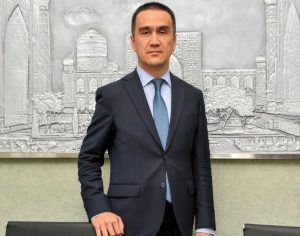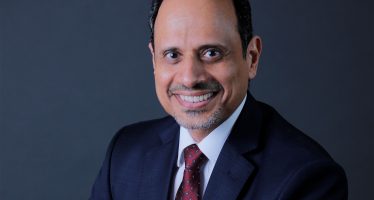Sherzod Khodjhaev, Deputy Minister for Energy, Republic of Uzbekistan: Uzbekistan Gets to Grips with Challenges of Responsible Electric Power Generation

Deputy Minister for Energy: Sherzod Khodjhaev
There is something magical about electricity: it has always been present, but its power was only harnessed at the end of the 19th Century.
In that relatively short time, it has become almost as necessary as oxygen to billions of people: we only truly notice electricity it when the supply is cut. When outages occur, cities — and even countries — become virtually paralysed. But 940m people, 13 percent of the world’s population, still don’t have access to electricity, or to the progress and prosperity it brings.
An outage in the UK last summer left almost a million people without an electricity supply — and they literally did not know what to do. From lighting to heating, internet to home entertainment systems, all appliances were becalmed. In the UK such outages are rare; in Uzbekistan, where a 100 percent electrification rate was achieved a few years ago, this is a more frequent occurrence.
It is estimated that in the 10 years facing us, world energy consumption will increase more than 55 percent. The more technologically advanced societies become, the more electricity is required. By 2030, electricity consumption in Uzbekistan is set to double. The Ministry of Energy was instructed to come up with a comprehensive plan to meet that demand.
The solution includes building a nuclear power station, commissioning new thermal power plants with an aggregate capacity of almost 8,000 megawatts over the next decade, and developing renewable sources of energy such as solar power and wind.
Power consumption in Uzbekistan for 2020 will be about 73bn kilowatt hours, which is nine percent more than the previous year. The demand from manufacturing industries is anticipated to grow by 10 percent, and domestic use will increase by 8.5 percent. The numbers reflect the growth of the Uzbek economy, improvements to the lives of its people, and the positive changes taking place in Uzbekistan.
The reform programme initiated by President Shavkat Mirziyoyev aims to meet these increasing demands of a growing population and a diversifying economy. There is an urgent need to ensure an ample, uninterrupted supply.
The country’s power supply system stretches around 255,000km, more than six times the length of the equator. Included are 9,700km of 220-500kV main overhead power transmission lines delivering electricity to some 33m people as well as industrial facilities. Such a network requires constant updating and repair, modernisation and the introduction of innovative technologies. Unfortunately, nearly 62 percent of the electricity network is more than 30 years old. Distribution networks are worn, which leads to a large loss of electricity — more than 13 percent of the total supplied by thermal power plants.
Uzbekistan is striving to become energy sufficient, as well as efficient. A lot of its gas is being used for power generation, something which can be avoided. Gas is a valuable and finite commodity that could be more carefully utilised for better returns. The solution is to diversify energy sources and direct efforts towards renewable sources, as well as more traditional generation methods.
Projects have been identified for the construction of solar and wind powerplants with a total capacity of 8,000 megawatts, with the engagement of foreign and domestic investors. Other projects anticipate hydroelectric capacity rising, with plans for the construction of small hydropower stations in the private sector.
Uzbekistan is grateful for the support it receives from institutions including the World Bank, the European Bank for Reconstruction and Development (EBRD), and Asian Development Bank (ADB). They provide financial support and access to an international pool of expertise. Any organisation or company is only as good as the people working for it. The country has a highly educated population, but there is always a need for further learning and empowerment in the field of IT. A knowledge-sharing exercise is under way.
International co-operation efforts include the creation of a joint venture with Assystem, a French project management and engineering company, an agreement to undertake transmission and distribution projects within and without Uzbekistan, infrastructure activities, and a bid to update the national electrical grid.
A presidential decree was signed on November 23, 2016, for further modernisation and updating of low-voltage (0.4-6-10 kV) networks for 2017-2021. In 2020, 67.9bn kWh of electricity will be produced, including 61.4bn kWh at thermal plants and 6.5bn kWh at hydropower plants.
Total exports will amount to $128.8m (with $23.9m in the first quarter). In 2020, 2.15bn kWh of electricity will be exported to Afghanistan. At present, Uzbekistan has a total installed capacity of 15GW (gigawatts). Policymakers are aiming to double that by 2030, with nearly half of new capacity coming from renewable sources.
Consumption in the modern world comes with responsibility. Uzbekistan is working to implement modern management principles, corporate governance, and transparency in all entities. The country is aware of the high international standards of efficiency and monitoring of environmental impact.
Globally, the number of people without access to electricity fell to below one billion in 2017. This is great news — and not just for those gaining better opportunities. It’s also good news for the global economy. For the world’s remaining underdeveloped regions to participate in the global marketplace, universal access to modern forms of energy is essential. The big question is how these regions will develop capacity. In the increasingly globalised energy value-chain, they may play a vital role.
Recent progress in improving access to electricity has been concentrated in Asia. India has made significant advances. The biggest challenge remains in sub-Saharan Africa, where, according to the International Energy Agency, in 2017 there were still 600 million people with no electricity. The major task is not only connection to the grid, but a search for a sustainable addition of reliable power generation.
Reforms will only succeed with changes in attitude to efficiency, and increased understanding of strengths and weaknesses. The focus must be on minimising wastage and losses due to inefficiency, underinvestment and lack of accountability. Huge strides have been made in recent years, but there is a long road ahead.
Electricity has historically been a great enabler for economic development, social welfare and healthcare, and its role is increasing. Electrification of transport and heating defines the cornerstone of global energy supply. Contributing to the momentum is the promise of a cleaner supply, which will benefit the environment. Hopefully, these positive changes will bring an improved quality of life to many countries.
In 2020, three projects (totalling $978.4m) will be completed, including the construction of a first and second combined cycle gas turbine unit with an individual capacity of 280MW at the Takhiatash Thermal Power Plant. Also under construction is a second combined cycle gas turbine unit with a capacity of 450MW at the Turakhurgan Thermal Power Plant. A 17MW co-generation gas turbine unit at the Ferghana Thermal Power Centre and six power units (with a capacity of 150MW) will be upgraded and commissioned at the Syrdarya Thermal Power Plant.
Within the framework of state programmes, 2,718km of power transmission networks and 905 transformer points will be installed and reviewed, and 3,053km of transmission networks and 1,839 transformer points overhauled. i
You may have an interest in also reading…
Green Bonds: How Active Management Aims to Make the Most of a Dynamic Sector
The market for financing linked to environmentally friendly projects and companies has already reached $1trn by some measures and we
Meet the SATORP Team: Guardians of the Rolls-Royce of Refineries
Sulaiman M Ababtain Sulaiman M Ababtain, president and CEO of SATORP, oversees one of the world’s most advanced refineries, capable
A Bold Shift in the Desert: Saudi Arabia’s $100bn Mining Venture and the Future of Battery Metals
Saudi Arabia is accelerating its economic transformation. In its latest move to reduce reliance on the oil that has long



















































































